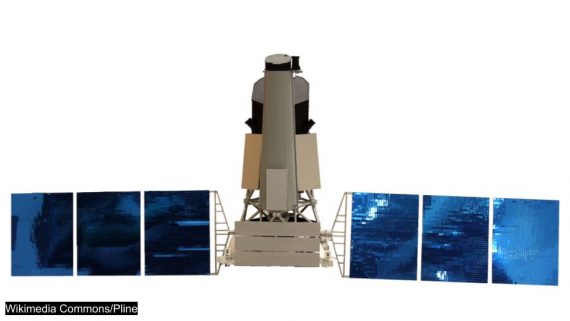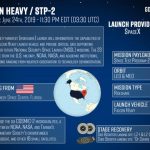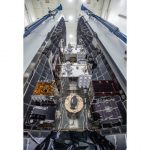<iframe src="https://youtu.be/mYlUmW4eNEY"></iframe>
The #DailySpace brings you the universe at 10am PST / 1pm EST / 5pm GMT on twitch.tv/CosmoQuestX. Today’s #spacenews includes:
June 20 @ 21:43 UTC – Launch of an Ariane 5

AT&T T-16 — Satellite TV for more info: https://space.skyrocket.de/doc_sdat/directv-16.htm

Eutelsat-7C — Communications for more info: https://www.eutelsat.com/en/satellites/eutelsat-7-east.html
Orbit: GTO Lots of details in those sites, including satellite pics, manufacturers, orbital slots, payloads, etc.

June 21 – 13:44 UTC
Proton-M carrying the Spektr-RG (SPACE TELESCOPE) X-ray! (photo above)
Launch DTG: 21JUN121714 GMT (8:17:14 a.m. EDT; 5:17:14 p.m. Baikonur time)
Spacecraft is joint Russian-German projectm destined for the Earth-Sun L2 Lagrange Point area
Spektr-RG is a joint project between Roscosmos and DLR, the Russian and German space agencies. The mission will conduct an all-sky X-ray survey, observing galaxies and large-scale galactic clusters to help astronomers examine the role of dark energy and dark matter in the evolution of the universe.
The primary instrument on Spektr-RG is the German-built wide-field eROSITA X-ray telescope, which scientists say will observe more than 3 million active black holes at the centers of galaxies, and approximately 100,000 clusters of galaxies in the distant universe.
A second X-ray telescope on Spektr-RG, developed by a Russian science team, will be sensitive to higher-energy X-rays than eROSITA. The Russian telescope, named ART-XC, will fly with X-ray mirror modules fabricated at NASA’s Marshall Space Flight Center in Alabama.
The mission is slated to last 6.5 years or thereabouts.

June 22 – no time posted – NO LIVE STREAM
3 Earth observation satellites! One specifically for polar observation
BNU-1 – Polar Observation Small Satellite; first remote sensing small satellite for polar observation
Ziyuan-2D, Tianyi MV-1
https://english.bnu.edu.cn/academicevents/107700.htm
https://forum.nasaspaceflight.com/index.php?topic=44952.0
June 23 – no time – NO LIVE STREAM
Smart Dragon First Flight!! LEO – Will launch 2 earth observation satellites
https://de.wikipedia.org/wiki/Jielong-1
Interesting note for western viewers: the company building this may be primarily civilian, but it was a direct spin-off from a state-owned company, which was a direct spin-off of the government space agency. There is NO firewall between China’s various governmental & civilian efforts in certain areas, something that’s really not appreciated by much of the rest of the casual viewing world.
We often joke about ‘the military-industrial complex’: China LIVES this principle to the hilt. It is the NORM for people who are general officers there to “retire” & take over CEO positions in ostensibly civilian companies there… not usually true in Western-style economies.

June 25 @ 3:30am UTC // June 24 @ 11:30pm east coast 4 hour launch window.
This launch is entitled Space Test Program 2, or STP-2 & is lead by the USAF.
Falcon Heavy Was on its way to the pad for scheduled Wed 19JUN test fire as of ~2230 EDT 18JUN / 0430 UTC 19JUN – LEO/MEO
The total of FOUR upper stage burns will be the most ever by a SpaceX vehicle. Over 20 small spacecraft! (The links below all say 24 satellites in three distinct orbits )
These include:
6x COSMIC-2 (227.8kg EACH)
E-TBEx
PSAT
TEPCE
ELaNa 15
Oculus-ASR nanosatellite
GPIM
Deep Space Atomic Clock
Prox-1 and LightSail 2
FOR MORE INFO/PICS:
Live coverage: https://spaceflightnow.com/2019/06/18/falcon-heavy-stp-2-launch-preps/
Article: https://spaceflightnow.com/2019/06/07/first-falcon-heavy-night-launch-slips-to-june-24/ — Nice big pic of the STP-2 mission patch in this link
3700kg Integrated Payload Stack!
https://twitter.com/AF_SMC/status/1141099481628364808
“Military officials originally intended for the STP-2 mission to be a test flight for the Falcon Heavy, and an opportunity to place a batch of experimental — and relatively low-cost and low-priority — payloads into orbit on a new rocket. But now the mission has evolved to become a critical test to move the Air Force closer to allowing more expensive national security satellites to launch on the Falcon Heavy, and potentially with reused booster stages.
“SpaceX has launched 21 missions with previously-flown booster stages — all successfully — with payloads for NASA and commercial customers.”
3rd of 3 flights necessary to certify Falcon Heavy for carrying valuable Air Force payloads!
2 of the side boosters have previously been flown, central core has not
“The main goal of this mission, rather than launching specific satellites, is the validate the Falcon Heavy system and a wide variety of its capabilities, including long coast, multiple engine restarts, direct MEO insertion and stage passivization, in order to certify it to fly operational US Air Force payloads to varied orbits. Therefore, the number and mass of payloads are effectively a “rideshare” with this primary mission, and of lesser importance.”
https://www.reddit.com/r/spacex/comments/bw6aa8/stp2_launch_campaign_thread/
 LightSail 2 and Prox-1
LightSail 2 and Prox-1
Prox-1 deploys the LightSail 2 spacecraft in Earth orbit.
At launch, LightSail 2 will be tucked inside Prox-1, a suitcase-sized spacecraft designed by students at Georgia Tech. Prox-1 was originally designed to chase down and rendezvous with LightSail 2, but its mission is now focused solely on deploying LightSail 2 into orbit.
The second satellite dropoff point is a circular, 720-kilometer-high orbit. Prox-1, carrying LightSail 2, will be first off the rocket here, about 1 hour and 20 minutes after launch.
Prox-1 will spend its first week circling Earth quietly, allowing time for the other spacecraft launched to the same orbit to drift away so that each can be identified individually. Precisely 7 days after its release from the Falcon Heavy, the front door of Prox-1’s CubeSat dispenser, called a P-POD, will swing open and allow a large spring to nudge LightSail 2 out into space.
http://www.planetary.org/blogs/jason-davis/what-to-expect-lightsail-2.html

LightSail 1 updated solar sail selfie
This image was captured by a camera aboard LightSail 1 on June 8, 2015, shortly after solar sail deployment. It was color-corrected by Dan Slater to remove the camera’s artificial purplish tint based on ground test images, and is a closer approximation to what the human eye would see.

Keep mapping Bennu!
Join us tomorrow for more Daily Space news!









 Join the Crew!
Join the Crew!
 Escape Velocity Space News
Escape Velocity Space News
0 Comments